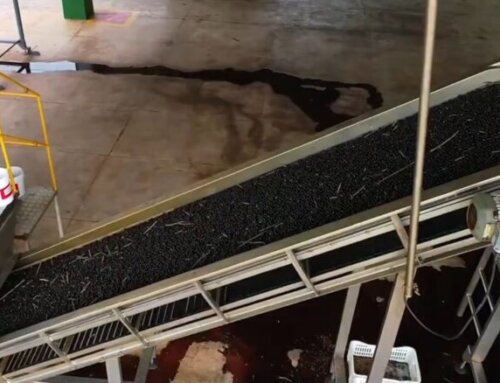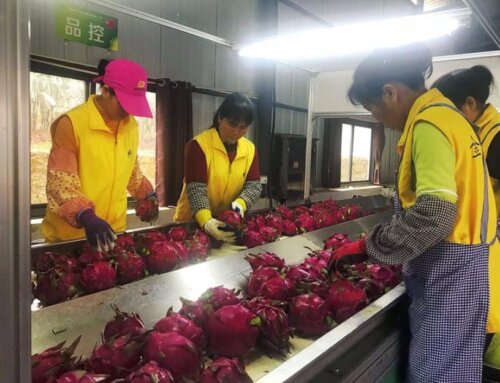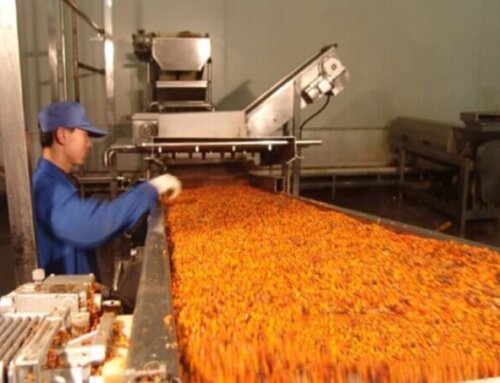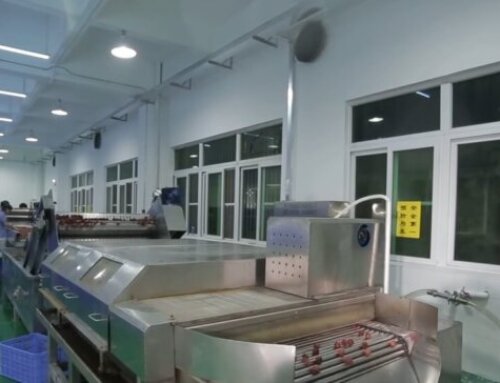Project Description
Tomato Processing Line
Tomato Production Line Characteristics
1. The whole tomato paste processing line includes a lifting system, a bubble water cleaning system, a sorting system, a crushing system, a preheating enzyme inactivation system, a pulping system, vacuum concentration system, a sterilizing system and an aseptic bag filling system.
2. Tomato paste production capacity ranges from 20T/D to 1500T/D. The tomato paste concentration rate is 28%-30% or 36%-38%.
3. Using the special effect of the crusher and low-temperature concentration (the first effective evaporation temperature is less than 70 ° C), the material stays in the evaporator for a short time, and the loss of nutrients such as red pigment (ketchup) is small.
4. The whole tomato processing line is fully automatic and all the control parts are using internationally famous brands such as SIEMENS PLC, SCHNEIDER electronic parts, DANFOSS converter and other world-class brand parts to ensure the whole processing line with high performance.
5. Tomato paste production uses a low-temperature vacuum evaporator that significantly reduces energy consumption while maximizing the preservation of tomato flavor and nutrients by operating at low temperatures. The evaporator’s cooling water system features an outer tank recirculation design, minimizing water waste. Additionally, it incorporates a secondary steam condensation recovery system that greatly reduces steam usage, enhancing overall energy efficiency.
6. The entire process design and pipeline connection layout take into account the retention of the original natural aromatic components of the ketchup product. The entire cooling and heating process and material transfer are completed in a short time and a short distance, which effectively prevents the heat-sensitive reflection of flavor substances from escaping; at the same time, it reduces the quality damage caused by the oxidation reaction of tomato puree under high temperature.
7. The tomato paste processing line’s main equipment is all SUS304/316 material, which ensures the end products are of high quality and hygiene.
8. We provide customized solutions for processing tomato paste, tomato puree, tomato ketchup, tomato juice, and tomato powder products tailored to meet each customer’s specific requirements. The tomato end products can be filled into aseptic bags, flexible pouches, metal cans, small sachets, bottles or cartons.
9. All the tomato processing machines are linked to start and stop and are controlled by a PLC, which greatly saves labor and enhances production efficiency.
10. The tomato paste production process typically involves several stages, including washing, sorting, hot or cold breaking, preheating, pulping, concentrating, sterilizing, and filling.
The End Product and Package of Tomato Processing Line
—Concentrated tomato paste: Produced from fresh tomatoes with 4–6°Brix, concentrated to 28–30°Brix (hot break) or 36–38°Brix (cold break). The finished paste is filled into aseptic bags (5 kg–1000 kg), tin cans (100 g–2500 g), or sachets (5 g–100 g) for long shelf life and easy transportation.
—Tomato puree: It is made from fresh tomatoes that are washed, sorted, crushed, and milled into a thick liquid without adding or removing significant substances, with a Brix value of 4–6°Brix. Tomato puree can be packed into pouches, tin cans, bottles, or tubes for retail or foodservice use.
—Tomato sauce: Use concentrated tomato paste as raw material, mixed with water, sugar, salt, seasonings and other ingredients and make it into 12-24brix tomato sauce, then fill it into small containers like PET/glass bottles, tin cans, sachets, brick cartons, pouches and other packages.
—Tomato Juice: the processing flowchart is similar to tomato ketchup or tomato sauce. But tomato juice has a lower viscosity and it is a beverage that can drink directly.
—Tomato Powder: Produced by pulping fresh tomatoes, concentrating them into tomato paste, and then spray drying to create tomato powder with 4%–5% moisture content. The powder is packaged in pouches for convenient storage, transport, and reconstitution.
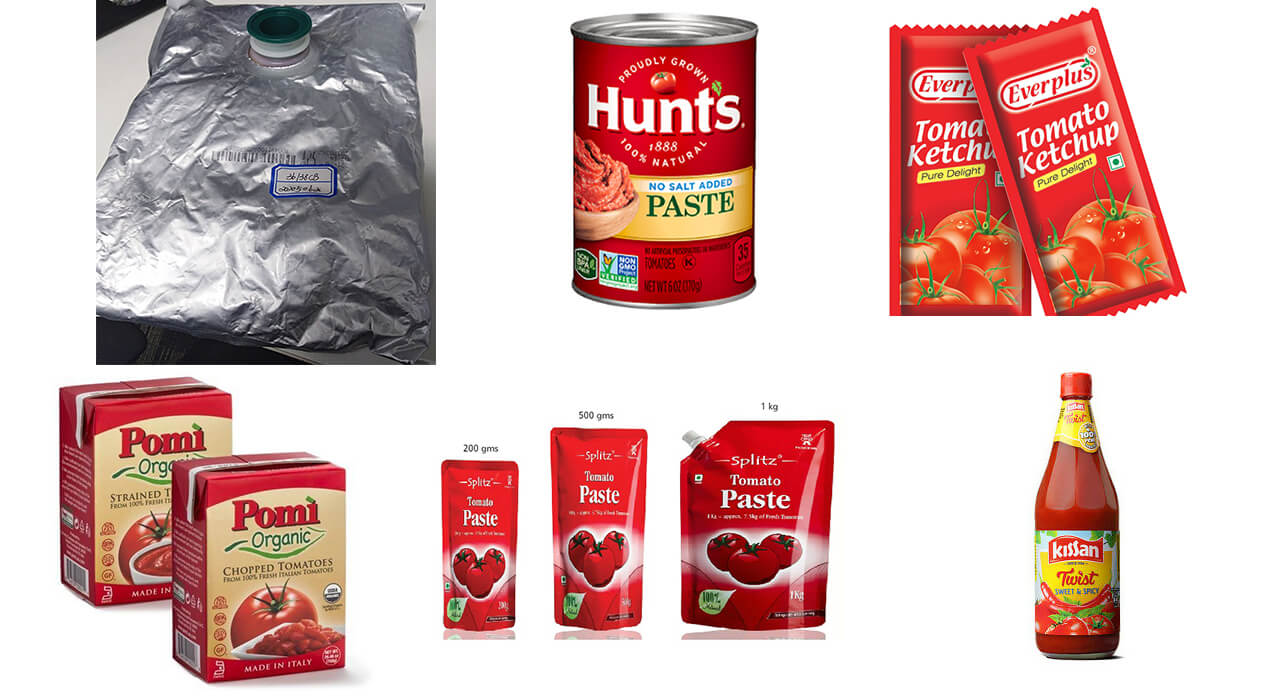
Tomato Paste Processing Line Production Process
Concentrated Tomato Paste: The concentrated tomato paste production process includes air-blowing washing to remove impurities, roller sorting to ensure only the best tomatoes are used, hammer crushing for efficient size reduction, tubular preheating to inactivate enzymes, and double-stage pulping and refining for smooth texture and consistent quality. The puree is then concentrated through a forced-circulation evaporator to the desired Brix level, followed by tube-in-tube sterilization to ensure food safety and extended shelf life. Finally, the tomato paste is aseptically filled into large aseptic bags or small retail packages, ready for storage, transport, or further processing.
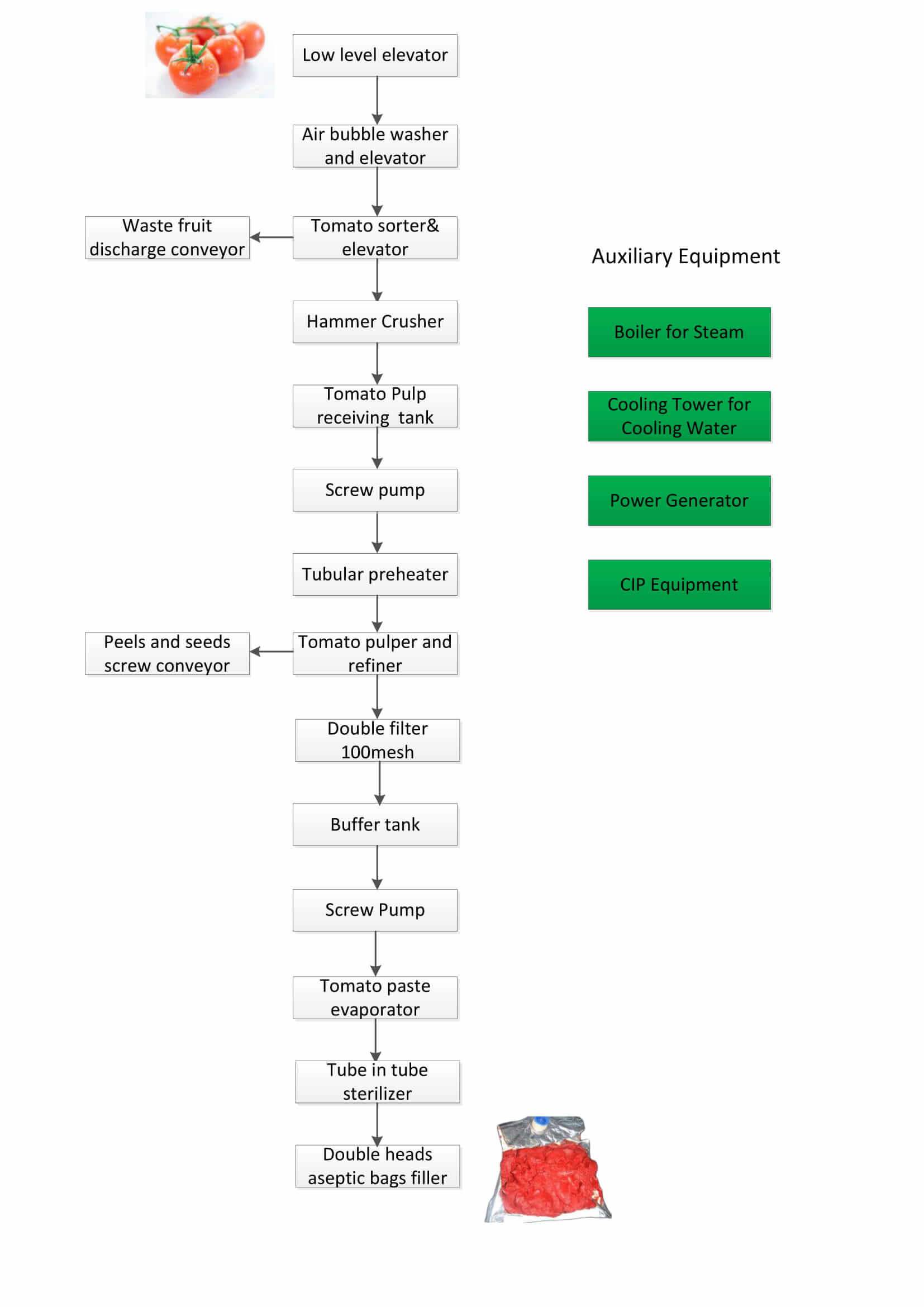
Key Machine of The Tomato Paste Production Line
Fresh tomato washing and sorting machine
Fresh tomatoes are first washed using an air bubble washing machine to ensure they are thoroughly cleaned before processing. This step is essential for producing high-quality tomato paste.
Inside the water tank, air bubbles are injected to create turbulence, effectively loosening dirt, dust, leaves, and other contaminants from the tomato surface. The combination of water immersion, air bubble agitation, and gentle mechanical movement removes impurities without damaging the tomato skin or causing bruising.
After bubble washing, the tomatoes are lifted from the tank and rinsed with high-pressure fresh water, ensuring complete removal of remaining debris.
The cleaned tomatoes then enter the roller sorting conveyor, where workers visually inspect and remove damaged, unripe, or green tomatoes. The conveyor system can also sort tomatoes by size using the spacing between rollers, ensuring only the best raw materials are sent to the next stage of processing.
This washing and sorting stage is a critical part of the tomato paste production line, as it ensures that only clean, ripe, and high-quality tomatoes are used, improving the final product’s taste, color, and shelf life.
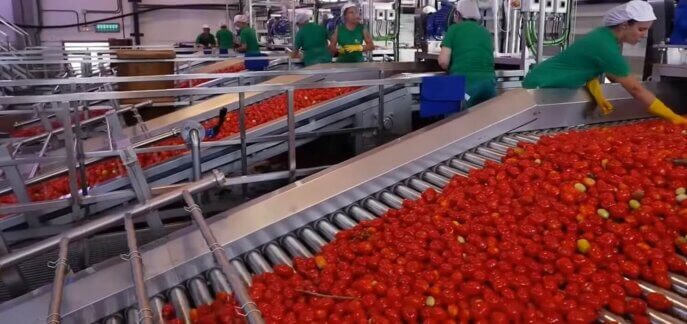
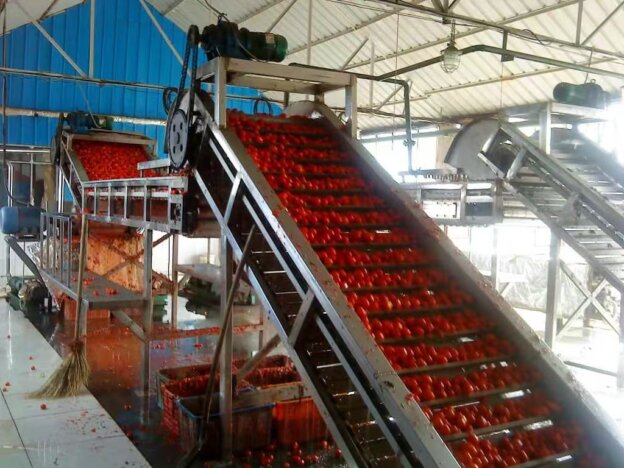
Tomato crusher and pulping machine
After obtaining clean, high-quality fresh tomatoes, they are fed into a hammer crusher or crusher pump to break them down into 3–5 mm particles. The crushed tomatoes are then transferred to a double-stage pulping machine to produce a smooth tomato pulp with a particle size of 0.4–0.6 mm.
To increase pulp yield, the tomato mash is first heated in a tubular preheater to 60 °C for 15 minutes before pulping. This preheating process improves extraction efficiency and helps release more pulp from the fruit.
The double-stage pulping machine achieves a pulp yield rate of about 90%, efficiently separating tomato skins and seeds from the pulp. This extracted pulp serves as the base for producing tomato paste, sauces, ketchup, and other tomato-based products.
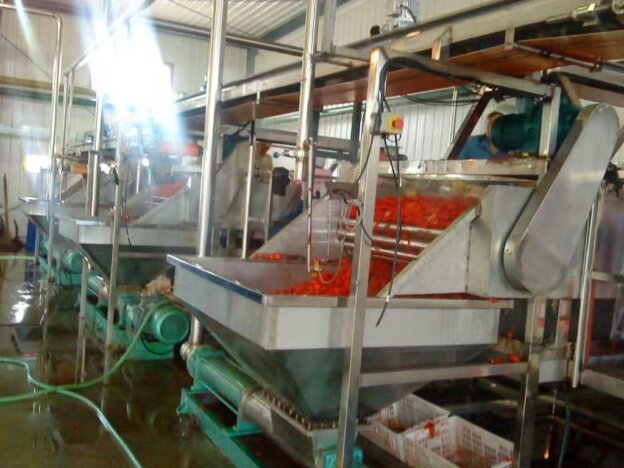
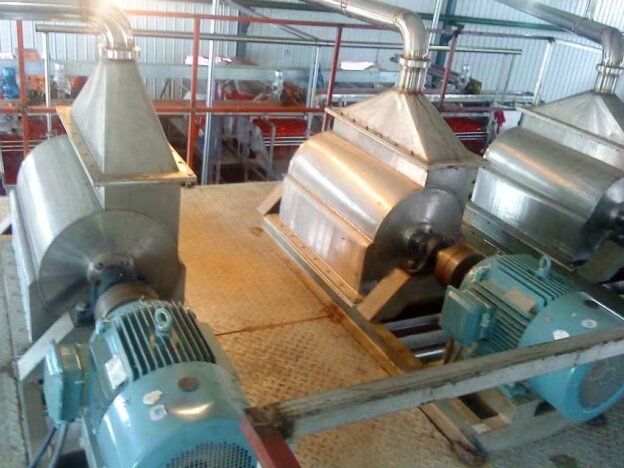
Tomato pulp preheating system
We use a tubular-type preheater to process tomato pulp, with two different heating methods depending on the desired product:
-
Hot Break Process: The tomato pulp is heated to 85–90 °C for 10–15 minutes.
-
Cold Break Process: The tomato pulp is heated to 55–60 °C for 10–15 minutes.
Both methods effectively destroy pectinase enzyme activity, helping to retain more natural pectin, maintain desired product viscosity, soften the pulp for easier separation, and improve the overall pulp extraction rate.
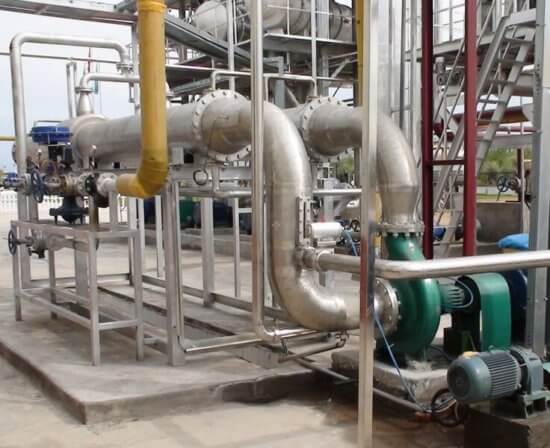
Tomato paste evaporator and sterilizer
The forced-circulation evaporator concentrates raw tomato pulp (about 5 °Brix) into tomato paste with a final concentration of 28–30 °Brix or 36–38 °Brix. This system uses a combination of heat and vacuum pressure to remove water from the pulp, producing a thick, high-quality paste.
The evaporator typically consists of a large cylindrical vessel with a heating jacket, a steam inlet, and a vacuum system. Tomato pulp is fed into the vessel and heated under controlled conditions, allowing water to evaporate while preserving the flavor, color, and nutrients of the tomatoes.
After concentration, the paste is sterilized using a tube-in-tube sterilizer to ensure long shelf life. The standard sterilization process heats the paste to 108–110 °C, holding it for 120 seconds to eliminate harmful bacteria. The sterilizer includes a tube-in-tube heat exchanger and a temperature control system. Tomato paste is pumped into the heat exchanger by a high-pressure pump, quickly heated to the required temperature, held, then rapidly cooled before aseptic packaging.
Both the evaporator and sterilizer are fully automatic, equipped with internationally recognized brand control components, and manufactured from SUS304/316 stainless steel to ensure durability, hygiene, and consistent product quality.
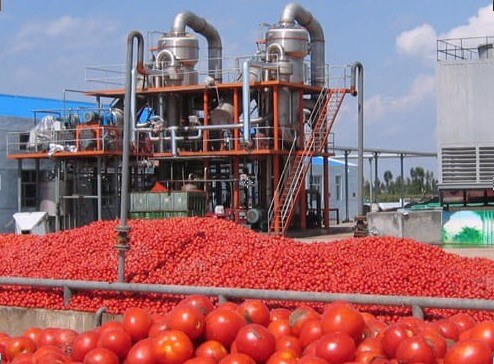

Tomato paste filler
After sterilization with the tube-in-tube sterilizer, the tomato paste is transferred to an aseptic filling machine for packaging into 5 kg–1000 kg aseptic bags. The filling process is carried out in a completely sterile environment at a temperature of about 30 °C. To maintain aseptic conditions, the filling chamber is sterilized with steam, and the entire operation is performed in a fully enclosed system. Tomato paste packaged in aseptic bags can achieve a shelf life of up to 2 years without preservatives.
In addition to aseptic bag packaging, concentrated tomato paste can also be filled into metal cans for use as cooking ingredients. This packaging format is especially popular in African and Middle Eastern markets. Tomato paste metal can filling machines are widely used in large-scale food processing facilities for their ability to fill and seal cans quickly, accurately, and consistently. These machines help reduce labor costs, increase production capacity, and ensure product quality during distribution to consumers.
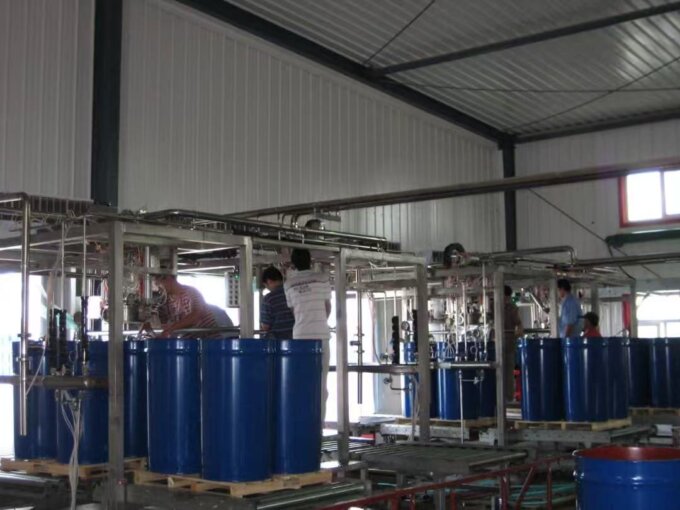
Video Performance
FAQ For Tomato Paste Processing Line
What information do you need to provide when you request a quotation?
Please provide the below-detailed information as much as possible:
- What is end products do you want to produce?
—Our machine can make concentrated tomato paste, tomato puree, tomato juice, tomato ketchup or tomato sauce.
- How many tons of fresh raw tomatoes can you supply per day?
—We supply machines from 20 tons per day to 1500 tons per day.
- What containers do you want to fill, aseptic bags in drums, tin cans, sachets or other containers?
—Bag in drums tomato paste is for wholesalers who use it as raw materials to make tomato ketchup or sauce, whereas tomato paste in tin cans or sachets is for consumption as cooking ingredients.
- What is the Brix value do you require for the end products, 28-30 Brix or 36-38 Brix?
—Cold-breaking tomato paste means that after the tomato is broken, the enzyme is inactivated at <70°C (generally 65°C), and then concentrated to 36-38 brix, and the viscosity of the cold break tomato paste will be low, but the flavor and color are good; The hot-breaking paste is the enzyme is inactivated after the tomato is broken at> 80°C (generally 85 or 90°C), and then concentrated to 28- 30 brix, the viscosity is higher, the flavor and color are poor. Usually, if your tomato capacity is below 250TPD, we do not suggest that you produce 36-38 Brix Tomato paste.
Can we produce 8 hours a day?
We do not suggest that, because if you produce 8 hours a day, then the production line needs to be stopped every day, when the production stop, you need to do the CIP cleaning, then it will cause a lot of waste of raw materials and lower down the whole production line efficiency(Especially the tomato paste in the evaporator).
What auxiliary equipment do we need for tomato paste processing?
–The CIP system is optional because the evaporator and sterilizer have self CIP cleaning function.
–Oil boiler or gas boiler to generate steam, the tubular preheater, sterilizer, evaporator and CIP system all need steam to heat the material.
–Cooling water tower to generate cooling water. The sterilizer, tomato paste evaporator all need cooling water to cool down material after heating.
–Air compressor to generate compressed air. The pneumatic valve group in the production line needs compressed air to perform its actions.
–RO soft water system. The soft water can be used for CIP cleaning water and evaporating water.
